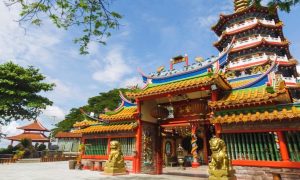Penang’s Culinary Heritage

Penang’s food scene is almost legendary, with many making the journey just to savour the island’s delectable delights. Kat Fatland lets her taste buds do the talking as she discovers the trail to culinary excellence.
For food lovers like me, Penang is heaven on earth, a prandial theme park. It took me approximately three meals after my arrival here to acknowledge (quietly and to myself at first) that this little island off the coast of Malaysia offered perhaps the greatest food in Southeast Asia. Ten meals later and a little more vocally, I determined that Penang’s food topped my personal list of worldly culinary delights. Nowadays, hundreds of plates into my love affair with George Town’s fare, I can only use superlatives to describe my affection for Hokkien mee, laksa, and roti canai. Now, like almost every Penangite I know, I, too, feel the surge of anger rise in my throat when somebody tries to tell me the char kuey teow stall they frequent is better than mine. More than a year after my first nasi lemak, I have slowly come to learn the importance of that ubiquitous greeting here: “Have you taken your lunch?”
Having come to Penang from the Midwestern plains of the United States, I was fairly unfamiliar with the idea of any sort of “culinary heritage.”Where I’m from, the tradition begins and ends with meat and potatoes, with the occasional casserole thrown in for good measure. On a larger scale, given the States’ relatively young age and its general movement towards “newness,” our traditions seem to change with every generation. Cooking with what resources were available in your community was eventually replaced with cooking with what was convenient, all the better if it was microwaveable. Recently, this has been replaced by movement of the “locavores,” going back to slow, “whole” food. For all of these reasons, it was hard for me to conceive of food as providing any perspective on history, let alone playing a major part.
Diversifying the Palate
Here in Penang, the best of the hawkers are worshipped as kings and queens: mad scientists who have found the perfect blend of flavours to satisfy the deepest desires of our appetites. From the plates of noodles to strips of roast duck atop a heaping portion of flavourful rice, diverse dishes abound on every street corner.There’s a creativity here that would make a Michelin-starred chef weep. But although your taste buds may disagree, there is more to the food here, than merely the flavours. Street fare here is truly ‘fast food’: watching hawkers flip their chapattis, rapidly fry their spice pastes in their woks, or expertly wrap their rice and curry tightly into a bright green banana leaf, is a memorable experience. Food is an event, a celebration, and everybody here knows it. And it is a celebration offered for prices so cheap that everyone can partake of it – and that’s a beautiful thing. Besides providing its participants with fond memories and stories, the food also provides delicious insight into Penang’s vibrant past.
Unlike my hometown, Penang’s culinary heritage is as rich and colourful as its famed shop houses that line the streets. In fact, the island’s unique flavours began to marinate together before my country even came into being. While many landlocked countries’ traditional meals historically relied on local ingredients as a matter of course, Penang’s early status as an important shipping hub resulted in an influx of migrant traders and workers from all round the region, bringing with them their homeland’s cuisine preferences.The Hokkiens from the Fujian province of China brought their tradition of pickling and drying foods, which began as a means to stave off famines – a reasonable explanation to the countless pickled fruit stalls found in and around Penang’s Chowrasta Market. With their home province being China’s largest bamboo-growing region, the Hokkiens also brought with them bamboo shoots, which were once featured in traditional poh piah rolls – thin crepes filled with julienned vegetables and pork belly – but have since been replaced with grated turnip or jicama.
A large influx of South Indian migrants from Tamil Nadu, referred to historically as the Chulias, introduced dhal (lentils) and curry leaves into the mix, and brought the very first mamak stalls to the streets of George Town. It has been said that one of those South Indian food sellers on Chulia Street “pulled” Penang’s first teh tarik, literally meaning “pulled (or stretched) tea.” A large portion of the later wave of Hainanese migrants worked as cooks and domestic servants to the British. These migrants took their own culinary heritage and blended it with that of the British to create a truly unique fusion fare, of which the Hainanese chicken puff, which takes the concept of a samosa and adds Hainanese spices and British puff pastry, makes a perfect example. Of course, Penang did not start off a blank slate: Malay kampung ingredients played prominently into the eventual blend of flavours. The abundance of paddy fields lined with coconut palms provided communities with the two main ingredients for one of Penang’s most beloved fares – nasi lemak, which is rice boiled with coconut milk (the “fatty” or lemak part), garnished with various side dishes such as peanuts, dried anchovies, cucumbers, boiled eggs, and fiery sambal, typically made with shrimp paste.
Fusion of Flavours
Over time, this diverse mixture of migrants and locals began to mix their favourite flavours with one another’s, creating those dishes that have come to be beloved on the streets of Penang today. As a result of the Hokkien influence, mamaks began selling mee goreng and mee rebus, fried noodles and boiled noodles respectively, made with distinctively Hokkien or Chinese ingredients such as tofu and bean sprouts.The rich sauce that covers mee rebus includes the Malay flavour of assam, or tamarind, the Hokkien flavour of dried shrimp, and the traditional Indian ingredient of boiled potatoes.
The incredible blending of these different cultures’ ingredients is a deliciously tangible representation of the unique blend of the cultures themselves, which is itself manifested in many distinctive features of Penang’s famous heritage – from its architecture to its varied places of worship. In this sense, those dishes travellers come to know and love here in Penang are so much more than just a delicious mouthful. They are an intimate part of the Penang identity: one that tells a history as rich and colourful as the sambal topping your favourite rice dish. The layers and history behind each of Penang’s rich culinary offerings makes the fare here taste all the more memorable.
For more information on the history of Penang’s food, see Penang Heritage Food by Ong Jin Teong, sold at Kinokuniya and other bookstores around Malaysia.
Source: Senses of Malaysia November/December 2013
Read more:
- An Island of Food
- Penang, a Food Paradise for Vegetarians
- Langkawi and Penang: A Tale of Two Islands
What are your thoughts on this article? Let us know by commenting below.No registration needed.















